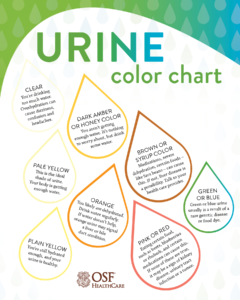Your urine’s got a message for you.
Urine is a part of daily life. Because it’s so routine, we probably don’t pay too much attention to what comes out when we empty our bladders. But urine color can actually communicate messages to us about our bodies.
“Urine color can tell you a lot about what is going on in your body,” said Alyssa Smolen, an advanced practice registered nurse at OSF HealthCare.
Urine can range anywhere from clear to light yellow to dark yellow to amber or brown. It can even show up orange, red or green.
Healthy urine color
Urine is made by the kidneys when they filter extra water and waste from the blood. The extra waste and water go from the blood to the kidneys, down two tubes called ureters, all the way to the bladder. The bladder holds the urine until we release it.

What does your urine say?
Download
“Normal urine is pale yellow to amber in color and is clear. Darker urine is often a sign of dehydration. If you notice that your urine is darker than normal and you have no other symptoms, try drinking some more water and see if this helps your urine return to a lighter color,” Alyssa said.
When you’re drinking enough water, your urine should be the right shade of yellow. An average adult should drink 12 8-ounce glasses of water every day.
When urine changes color
If your urine changes color, that’s when it’s time to pay attention.
“Urine color can change due to hydration status, medications, foods or dyes, infection or changes in liver or kidney function,” Alyssa said.
The more unusual colors – like bright highlighter yellow, orange, brown, green or blue – are likely caused by medications, changes in diet or food dyes.
Even vigorous exercise can cause urine to change to a pink, red or tea-colored hue. This is because exercise can cause blood to mix with urine. It’s usually nothing to worry about, so long as your urine is back to a pale yellow or amber color within a day. If the color change lasts longer than a day, reach out to your health care provider to get it checked out. They’ll likely take a urine sample to test.
Urine may also come out pink or red because of a urinary tract infection (UTI) or kidney stones.
“If you notice your urine is a different color than normal, I recommend thinking about anything that may have changed in the last day or two,” Alyssa said.
She suggests asking yourself questions like,
Time to talk to a provider?
- Were you more active or exercising more than normal?
- Did you drink enough water?
- Are you taking any new medications or supplements?
- Have you eaten any different foods or a large amount of a particular food? Common foods known to cause urine to change color include beets, blackberries, rhubarb, fava beans and foods with brightly colored dyes.
- Are you experiencing any other symptoms, such as urinary frequency changes, urinary urgency, painful urination, abdominal pain, lower back pain or fever?
When to call the doctor
Your urine shouldn’t be cloudy or fizzy. If you notice your urine is cloudy or fizzy, it’s nothing to be too concerned about. It should clear up on its own, but if either symptom persists, it’s time to talk to your primary care provider. It could signal a problem with your diet or kidney function.
“If you have no other symptoms and can identify a potential cause for the change, it’s probably OK to monitor things at home for a day or two. If you have other symptoms, you should call your health care provider,” Alyssa said.
